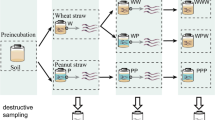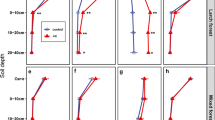Abstract
Both litter composition and site environment are important factors influencing litter decomposition, but their relative roles in driving spatial variation in litter decomposition among wetlands remain unclear. The responses of mass loss and nutrient dynamics to site environment and litter source were investigated in Carex brevicuspis leaves from the Dongting Lake wetlands, China, using reciprocal transplants of litterbags. Litters originating from lower elevation (24–25 m; flooded for 180–200 days every year) and higher elevation (27–28 m; flooded for 60–90 days every year) sites were incubated simultaneously at lower and higher sites at three locations for 1 year. The remaining litter mass, N, P, and lignin contents were analyzed during decomposition. Initial N and P contents were richer in litters from lower sites than those from higher ones. The decomposition rate was higher for the litters originating from lower sites (0.0030 day−1) than those from higher ones (0.0025 day−1) and higher at lower sites (0.0031 day−1) than at higher sites (0.0024 day−1). Litters from lower sites displayed greater N and P mineralization than those from higher sites, whereas only P dynamics were affected by site elevation. The variation in litter decomposition rate among the different litter source groups was twice that among the different site elevation groups. These data indicate that, in wetlands ecosystems, litter composition plays a more important role in the speed of litter decomposition than site environment (here represented by site elevation).

Similar content being viewed by others
References
Aerts R, van Bodegom PM, Cornelissen JHC. 2012. Litter stoichiometric traits of plant species of high-latitude ecosystems show high responsiveness to global change without causing strong variation in litter decomposition. New Phytol 196:181–8.
Battle JM, Golladay SW. 2001. Hydroperiod influence on breakdown of leaf litter in cypress-gum wetlands. Am Midl Nat 146:128–45.
Berger TW, Duboc O, Djukic I, Tatzber M, Gerzabek MH, Zehetner F. 2015. Decomposition of beech (Fagus sylvatica) and pine (Pinus nigra) litter along an Alpine elevation gradient: decay and nutrient release. Geoderma 251–252:92–104.
Bradford MA, Berg B, Maynard DS, Wieder WR, Wood SA. 2015. Understanding the dominant controls on litter decomposition. J Ecol 104(1):229–38.
Brovkin V, van Bodegom PM, Kleinen T, Wirth C, Cornwell WK, Cornelissen JHC, Kattge J. 2012. Plant-driven variation in decomposition rates improves projections of global litter stock distribution. Biogeosciences 9:565–76.
Chen XS, Li X, Xie YH, Li F, Hou ZY, Zeng J. 2015. Combined influence of hydrological gradient and edaphic factors on the distribution of macrophyte communities in Dongting Lake wetlands, China. Wetlands Ecol Manage 23:481–90.
Cusack DF, Chou WW, Yang WH, Harmon ME, Silver WL, The LIDET Team. 2009. Controls on long-term root and leaf litter decomposition in neotropical forests. Global Change Biol 15:1339–55.
Deng ZM, Chen XS, Xie YH, Pan Y, Li F, Hou ZY, Li X, Xie YJ. 2013. Plasticity of the clonal growth in the wetland sedge Carex brevicuspis along a small-scale elevation. Ann Bot Fenn 50:151–9.
Fonseca AL, Bianchini I, Pimenta CM, Soares CB, Mangiavacchi N. 2013. The flow velocity as driving force for decomposition of leaves and twigs. Hydrobiologia 703:59–67.
González E, Muller E, Comín FA. 2010. Leaf nutrient concentration as an indicator of Populus and Tamarix response to flooding. Perspect Plant Ecol 12:257–66.
Graça MA, Bälocher F, Gessner MO, Eds. 2005. Methods to study litter decomposition: a practical Guide. Amsterdam: Springer.
Harner MJ, Crenshaw CL, Abelho M, Stursova M, Follstad Shah JJ, Sinsabaugh RL. 2009. Decomposition of leaf litter from a native tree and an actinorhizal invasive across riparian habitats. Ecol Appl 19(5):1135–46.
Hobbie SE, Gough L. 2004. Litter decomposition in moist acidic and non-acidic tundra with different glacial histories. Oecologia 140:113–24.
Hobbie SH, Reich PB, Oleksyn J, Ogdahl M, Zytkowiak R, Hale C, Karolewski P. 2006. Tree species effects on decomposition and forest floor dynamics in a common garden. Ecology 87(9):2288–97.
Hu JY, Xie YH, Li F, Hou ZY. 2014. Characteristics of Carex brevicuspis and its impact factors in Dingzidi, East Dongting Lake. Chin J Appl Ecol 25(3):745–51.
Keuskamp JA, Hefting MM, Dingemans BJJ, Verhoeven JTA, Feller IC. 2015. Effects of nutrient enrichment on mangrove leaf litter decomposition. Sci Total Environ 508:402–10.
Langhans SD, Tiegs SD, Gessner MO, Tockner K. 2008. Leaf-decomposition heterogeneity across a riverine floodplain mosaic. Aquat Sci 70:337–46.
Liu YY, Sun QY, Li F, Xie YH. 2013. Soil microbial characteristics of Dongting Lake wetlands with different typical vegetation communities. Chin J Ecol 32(5):1233–7.
Makkonen M, Berg MP, Handa IT, Hättenschwiler S, van Ruijven J, van Bodegom PM, Aerts R. 2012. Highly consistent effects of plant litter identity and functional traits on decomposition across a latitudinal gradient. Ecol Lett 15:1033–41.
Manning P, Saunders M, Bardgett RD, Bonkowski M, Bradford MA, Ellis RJ, Kandeler E, Marhan S, Tscherko D. 2008. Direct and indirect effects of nitrogen deposition on litter decomposition. Soil Biol Biochem 40:688–98.
Nicastro A, Onoda Y, Bishop MJ. 2012. Direct and indirect effects of tidal elevation on eelgrass decomposition. Mar Ecol Prog Ser 456:53–62.
Olson JS. 1963. Energy storage and the balance of producers and decomposers in ecological systems. Ecology 44:322–31.
Pettit NE, Davies T, Fellman JB, Grierson PF, Warfe DW, Davies PM. 2012. Leaf litter chemistry, decomposition and assimilation by macroinvertebrates in two tropical streams. Hydrobiologia 680:63–77.
Prescott CE. 2010. Litter decomposition: what controls it and how can we alter it to sequester more carbon in forest soils? Biogeochemistry 101:133–49.
Rejmánková E, Sirová D. 2006. Wetland plant decomposition under different nutrient conditions: what is more important, litter quality or site quality? Biogeochemistry 80:245–62.
Rejmánková E, Sirová D. 2007. Wetland macrophyte decomposition under different nutrient conditions: relationships between decomposition rate, enzyme activities and microbial biomass. Soil Biol Biochem 39:526–38.
Roehm CL. 2005. Respiration in wetland ecosystems. In: del Giorgio PA, Williams PJleB, Eds. Respiration in aquatic ecosystems. Oxford: Oxford University Press. pp. 83–102.
Schlesinger WH. 1996. Biogeochemistry, an analysis of global change. San Diego (CA): Academic Press.
Shilenkova OL, Tiunov AV. 2013. Soil–litter nitrogen transfer and changes in δ13C and δ15N values in decomposing leaf litter during laboratory incubation. Pedobiologia 56:147–52.
Tiegs SD, Akinwole PO, Gessner MO. 2009. Litter decomposition across multiple spatial scales in stream networks. Oecologia 61:343–51.
Vitousek PM. 2004. Nutrient cycling and limitation: Hawai’I as a model system. Princeton (NJ): Princeton University Press.
Vivanco L, Austin AT. 2008. Tree species identity alters forest litter decomposition through long-term plant and soil interactions in Patagonia, Argentina. Journal of Ecology 96:727–36.
Wallis E, Raulings E. 2011. Relationship between water regime and hummock-building by Melaleuca ericifolia and Phragmites australis in a brackish wetland. Aquat Bot 95:182–8.
Wang J, You YM, Tang ZX, Sun OJ. 2014. Variations in leaf litter decomposition across contrasting forest stands and controlling factors at local scale. J Plant Ecol 24(1):1–12.
Xie YJ, Xie YH, Hu C, Chen XS, Li F. 2016. Interaction between litter quality and simulated water depths on decomposition of two emergent macrophytes. J Limnol 75(1):36–43.
Zhao QQ, Bai JH, Liu PP, Gao HF, Wang JJ. 2015. Decomposition and carbon and nitrogen dynamics of Phragmites australis litter as affected by flooding periods in coastal wetlands. CSAWAC 43(3):441–5.
Zhou GY, Guan LL, Wei XH, Tang XL, Liu SG, Liu JX, Zhang DQ, Yan JH. 2008. Factors influencing leaf litter decomposition: an intersite decomposition experiment across China. Plant Soil 311:61–72.
Acknowledgements
This study was financially supported by the National Key Technology Research and Development Program of China (2014BAC09B03).
Author information
Authors and Affiliations
Corresponding authors
Additional information
Author contributions
Yajun Xie and Yonghong Xie conceived and designed study; Yajun Xie, Xinsheng Chen, and Feng Li performed research; Yajun Xie and Huayun Xiao analyzed data; and Yajun Xie wrote the paper.
Rights and permissions
About this article
Cite this article
Xie, Y., Xie, Y., Xiao, H. et al. Controls on Litter Decomposition of Emergent Macrophyte in Dongting Lake Wetlands. Ecosystems 20, 1383–1389 (2017). https://doi.org/10.1007/s10021-017-0119-y
Received:
Accepted:
Published:
Issue Date:
DOI: https://doi.org/10.1007/s10021-017-0119-y




